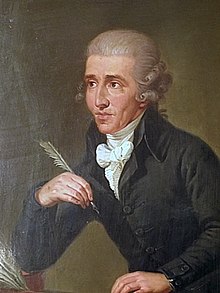F-sharp minor is a minor scale based on F♯, consisting of the pitches F♯, G♯, A, B, C♯, D, and E. Its key signature has three sharps. Its relative major is A major and its parallel major is F-sharp major.
The Symphony No. 102 in B♭ major, Hoboken I/102, is the tenth of the twelve London symphonies written by Joseph Haydn, at the instigation of impresario Johann Peter Salomon. It is one of three symphonies he worked on in 1794, along with his 103 and 104th symphonies. Despite being lesser-known than many of the other works in the group, it is sometimes viewed as Haydn's best symphony, in terms of successful use of compositional strengths unified in a quality undisturbed throughout the work.
The Symphony No. 78 in C minor, Hoboken 1/78, is a symphony by Joseph Haydn completed in 1782.

Joseph Haydn's Piano Trio No. 39 in G major, Hob. XV/25 was written in 1795, during the final few weeks of Haydn's second trip to London, and one of a set of three dedicated to Rebecca Schroeter. It is perhaps his best-known piano trio and sometimes nicknamed the "Gypsy" or "Gypsy Rondo" trio because of its Rondo finale in 'Hungarian' style.
Homotonal (same-tonality) is a technical musical term pertaining to the tonal structure of multi-movement compositions. It was introduced into musicology by Hans Keller. According to Keller's definition and usage, a multi-movement composition is 'homotonal' if all of its movements have the same tonic (keynote).

The Symphony No. 32 in C major is a festive symphony by Joseph Haydn. The exact date of composition is unknown. It has been suggested by noted Haydn scholar H.C. Robbins Landon that it could have been written as early as 1757 and as late as 1763. More recent scholars have suggested it was composed in either 1760 or 1761
The Piano Sonata in F major, Hob. XVI/9, L.3, also called a divertimento, was written before 1766 by Joseph Haydn. The 1st and 3rd movements are used as the 1st and 5th movements respectively of the Piano Trio in F major, Hob. XV/39. The Minuet of the 2nd movement is also used as the Minuet of the 4th movement of Hob. XV/39.
The Piano Sonata in D major, Hob. XIV/5, L.28, also called a divertimento, is a sonata written c.1765–1771 by Joseph Haydn. However, Anthony van Hoboken's catalogue states the composition date as "before 1766". It may have been written for 2 violins and cello.

The String Quartets, Op. 50, were composed by Joseph Haydn in 1787. The set of six quartets was dedicated to King Frederick William II of Prussia. For this reason the set is commonly known as the Prussian Quartets. Haydn sold the set to the Viennese firm Artaria and, without Artaria's knowledge, to the English publisher William Forster. Forster published it as Haydn's Opus 44. Haydn's autograph manuscripts for Nos. 3 to 6 of the set were discovered in Melbourne, Australia, in 1982.
Joseph Haydn's Piano Trio No. 41 in E-flat minor, Hob. XV/31, was written in 1795/1796, though not published until 1803 in Vienna. It has the nickname "Jacob's Dream" because of its second movement. On publication it was dedicated to Magdalena von Kurzböck (1767–1845), a Viennese pianist and composer.

Joseph Haydn's Piano Trio No. 44 in E major, Hob. XV/28 was published in 1797 but may have been written a few years earlier while Haydn was still in England on the second of his highly successful London visits. It is the second of a set of three trios dedicated to the eminent pianist Mrs. Therese Jansen Bartolozzi, and is noted for its especially wide expressive range as well as its virtuosity.
Joseph Haydn's Piano Trio No. 42 in E♭ major, Hob. XV/30 was completed in 1796 after his return to Vienna from England and first published there by Artaria in 1797. It is without a dedication: the piano part is less challenging than those trios dedicated to keyboard virtuosi. This is thought to have been Haydn's last piano trio and with a typical performance time of 20 minutes it is one of his largest. By the time of its publication, Beethoven had already published his first three piano trios setting a new direction for the form away from the ‘accompanied piano sonata’ towards a more equal and dramatic interplay between piano, violin, and cello.
Joseph Haydn's Piano Trio No. 40 in F♯ minor, Hob. XV:26, was completed during the final few weeks of Haydn's second trip to London, and one of a set of three dedicated to Rebecca Schroeter. With its unusual key, this piano trio has been described by Robert Philip as "subtle and shifting in its moods".

Joseph Haydn's Piano Trio No. 43 in C major, Hob XV:27, was published in 1797 while Haydn was still in England on the second of his highly successful London visits. It is the first of a a set of three trios dedicated to Mrs. Therese Jansen Bartolozzi. Batolozzi was an eminent pianist, and this trio is notable for its demanding piano part, at a time when the trio form was mostly associated with amateur performance.
Joseph Haydn's Piano Trio No. 45 in E♭ major, Hob. XV:29, was published in 1797 but may have been written a few years earlier, while Haydn was still in England on the second of his highly successful London visits. It is the third of a set of three trios dedicated to the eminent pianist Mrs. Therese Jansen Bartolozzi. It is the least technically sophisticated of the three in a set noted in general for their wide expressive range and virtuosity - piano trios at this time were typically written with amateur performers in mind. But it is still full of character and humour.


